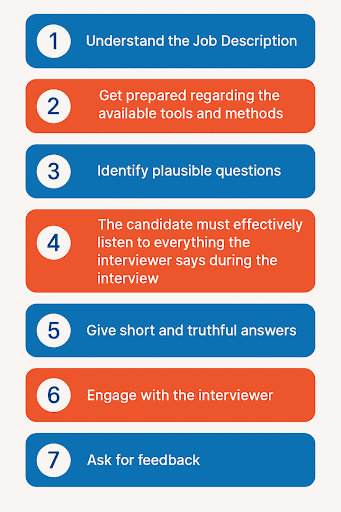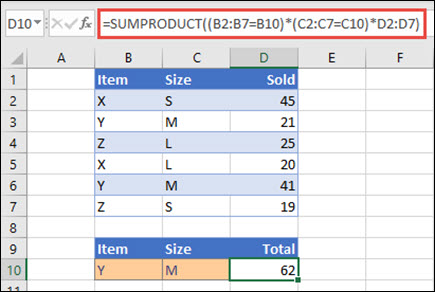Top 30 Excel Interview Questions and Answers for All Levels
Table of Contents

Microsoft Excel functions as a critical program that multiple industries adopt to streamline their data analysis. The automation function of MS Excel helps filter and sort data, generate reports, and help present the information in a lucid manner. As a result, every candidate, from freshers to experienced professionals, needs to prepare extensively for their Excel interview questions to succeed.
The following blog will outline 30 very important Excel interview questions and answers, which are categorized into different sections according to experience level.
How to Prepare for an Interview?
The initial step requires developing the resume alongside the job application. One will find these detailed guides on writing resumes:
To enhance the selection probability, one needs to follow certain steps. The first one is strengthening the resume for ATS, i.e., the Application Tracking System. The evaluation process requires candidates to identify specific keywords for their resume that will enable ATS screening systems to avoid discarding their application.
Consequent steps include:

- Step 1: Understand the Job Description
- Step 2: Get prepared regarding the available tools and methods
- Step 3: Identify plausible questions
- Step 4: The candidate must effectively listen to everything the interviewer says during the interview
- Step 5: Give short and truthful answers
- Step 6: Engage with the interviewer
- Step 7: Ask for feedback
As soon as the interview ends, one needs to request feedback. Knowing the weaknesses will help one become a more successful candidate.
The following section presents the essential Excel interview questions that one should know.
List of Top 30 Excel Interview Questions & Answers
An Excel test for an interview contains an assortment of questions. Thus, this blog splits its content into four distinct areas, which include basic, fresher, intermediate, and advanced-level Excel interview questions.
Basic Excel Interview Questions
The questions within this category are applicable for entry-level to expert Excel candidates. To evaluate the candidate’s basic Excel knowledge, the interviewers will begin with these questions.
- What is Excel?
Microsoft Excel functions as spreadsheet software within the Microsoft Office Suite. Users can use it to analyze and visualize data using tables, graphs, and charts in Excel. Through Excel, users can run calculations, handle big data sets, and develop automated procedures using formulas and macros.
- What is a formula in Excel?
Within Excel, a formula functions as an instruction set that enables either mathematical computations or alternative operations. All Excel formulas start with the equal sign (=) followed by mathematical expressions, operators, and cell references. For example, =SUM(A1:A10) adds the values in cells A1 to A10.
- What is the difference between a cell and a range in Excel?
A cell becomes the point where both row and column lines meet in Excel and contains a single piece of information. A range consists of multiple adjacent Excel cells, which users can choose for a multitude of tasks such as calculations, formatting, or copying.
- What is the use of the AutoSum feature in Excel?
Excel users can benefit from AutoSum, which automatically adds to chosen numerical fields. One can quickly calculate the sum by selecting a cell and clicking the AutoSum button on the Home tab.
- What is the difference between relative and absolute cell references in Excel?
Relative cell references such as A1 transform their values when one copies the formula to another cell. An absolute reference (e.g., $A$1) remains unchanged no matter where one copies the formula.
- How do you freeze panes in Excel?
The selection of Freeze Panes appears under the View tab. The Freeze Panes tool enables users to secure specific rows or columns, keeping designated sections visible even when they scroll through other parts of the worksheet.
Excel Interview Questions for Freshers
Freshers who come to Excel interviews need to demonstrate fundamental concepts and abilities required for their initial positions. The evaluation of basic Excel knowledge, including formula functions and data management methods, forms the basis of these Excel interview questions for freshers. The common Excel-related interview questions are:
- Through what method can you operate data sorting in Excel?
Choose the range of cells, access the Data tab, and click on the Sort button to organize data in Excel. The data sorting functionality allows users to organize their data either by alphabetical, numerical, or personal requirements.
- What is conditional formatting in Excel?
The feature of conditional formatting enables users to transform cell appearances through defined rules based on set criteria. The system provides an option to modify cell background color when cell values reach predefined thresholds.
- How to create a drop-down list in Excel?
Users should start by selecting their target cell, followed by browsing Data > Data Validation > List to establish the drop-down list feature and add desired items in the specified order. The list items can also be accessed through a set of cells.
- What is the difference between SUM and SUMIF functions?
SUM evaluates the total range, but SUMIF determines the values that match specific parameters. The SUMIF formula with the argument “A1:A10 >5” will evaluate and add together all values in cells A1:A10 that exceed 5.
- What is the CONCATENATE function in Excel?
This function creates one long textual output by merging two or more selected text components together. The formula “=CONCATENATE(A1, “ “, B1)” joins the cell contents of A1 together with B1 values through a space.
- What is a named range in Excel?
A named range provides the ability to give cells or ranges recognizable descriptive names. This offers simpler referencing abilities for cells in formulas. For instance, using the name “SalesData” for a cell range is more effective than using cell references like A1:A10.
- How to remove duplicates in Excel?
One can remove duplicates by selecting the data range, visiting the Data tab, and activating the Remove Duplicates command. Users can select the specific columns according to their wish to search for duplicates when removing the duplicates.
- What is the VLOOKUP function in Excel?
The VLOOKUP function allows users to search the first column of tables for specified values to retrieve values from different columns. For instance, a VLOOKUP search for A2 value =VLOOKUP(A2, B1:C10, 2, FALSE) retrieves its matching value in column C.
Intermediate MS Excel Interview Questions
The intermediate-level MS Excel interview questions assess one’s skills at handling advanced tasks by testing the appropriate usage of functions INDEX, MATCH, SUMIFS, and advanced data management procedures.
- What is a Pivot Table in Excel?
The Excel tool pivot table provides users with data summarization and organization capabilities for big datasets. Pivot tables enable users to combine multiple data evaluation techniques through grouping, filtering, and aggregating data sets. Pivot tables are used for both reporting functions and data analysis purposes.
- What is the INDEX and MATCH function combination in Excel?
Through the INDEX function, users can retrieve table values using specified row and column positions. INDEX function enables users to retrieve cell values that match selected row-column positions. The INDEX and MATCH functions together provide users with more flexibility than VLOOKUP does. For example, =INDEX(A1:A10, MATCH(“Apple”, B1:B10, 0)) returns the value from column A where “Apple” appears in column B.
- What is the difference between SUMIF and SUMIFS in Excel?
With the SUMIF function, users can add value ranges when meeting one specified criterion, but SUMIFS enables simultaneous addition for ranges meeting all specified criteria. For example, =SUMIFS(A1:A10, B1:B10, “>5”, C1:C10, “<10”) sums values in A1:A10 where corresponding values in B1:B10 are greater than 5 and values in C1:C10 are less than 10.
- How to use the IF function in Excel?
By using the IF function, users can evaluate conditional calculations. This logical function performs an evaluation to provide results from different value sets depending on whether the condition proves true or false. The syntax is =IF(condition, value_if_true, value_if_false). For example, =IF(A1 > 5, “Yes”, “No”) checks if the value in A1 is greater than 5 and returns “Yes” or “No” accordingly.
- What are Excel macros?
A single click of a macro key will activate the automated command sequences and actions written in VBA. VBA (Visual Basic for Applications) coding forms the basis of macros, which enable users to complete repetitive tasks automatically with a single click.
- What is a Power Query in Excel?
Excel users can access Power Query as a tool that enables data import, data transformation, and data cleaning from different sources. The tool automates data preparation work, which simplifies both data extraction and transformation steps.
- How to protect a worksheet in Excel?
The Review tab contains a Protect Sheet, which users must click to enable worksheet protection. Using a password function will stop unauthorized users from editing the sheet. The protection feature enables the safe sharing of files with others while maintaining certain data sections intact.
Advanced Excel Interview Questions
The interviewer asks advanced Excel interview questions that specifically gauge candidates’ ability to manage intricate statistical analysis and automation capabilities.
- What is the use of the SUMPRODUCT function in Excel?

*Microsoft support
The SUMPRODUCT function multiplies corresponding values in given arrays and returns the sum of the products. This function enables the calculation of weighted operations. For instance, the formula =SUMPRODUCT(A1:A10, B1:B10) performs multiplications between corresponding range pairs of cells in A1:A10 and B1:B10 and then calculates the overall sum.
- What is an array formula in Excel?
Within Excel, an array formula enables the simultaneous calculation of multiple values. Array formulas enable the analysis of multiple values within certain ranges. Users can access array formulas through the combination of shortcut keys Ctrl + Shift + Enter, but normal Enter does not work.
- What is the use of the TEXT function in Excel?
Excel users apply the TEXT function to display numbers, dates, and times as text strings. For instance, the command =TEXT(A1, “mm/dd/yyyy”) changes the A1 cell date value into a textual display using the “mm/dd/yyyy” format.
- What function distinguishes IFERROR from ISERROR in Excel applications?
The IFERROR function controls calculation error value handling by providing defined user results, while the ISERROR function verifies the error existence in Excel. The IFERROR function returns “Error” when A1 divided by B1 produces an error during calculation.
- How do you use COUNTIFS in Excel?
Users can determine cell counting through the use of the COUNTIFS function when multiple criteria apply. This formula displays a cell count when it matches the criteria of values > 5 in A1:A10 and < 10 in B1:B10 (the range of cells).
- Why do worksheets differ from workbooks inside the Excel application?
The Excel application features a workbook that provides users with a way to gather multiple worksheets together inside one file. A workbook possesses many different worksheets, which operate as tabs that implement a data entry system based on rows and columns.
- What is the use of the MATCH function in Excel?
Using the MATCH function allows users to find values in a specified range and get their position within the range. For example, =MATCH(“Apple”, A1:A10, 0) returns the position of “Apple” in the range A1:A10.
- What is the HLOOKUP function in Excel?
The HLOOKUP (Horizontal Lookup) function enables users to locate a value within a top table row, which returns corresponding data from a specified column. The HLOOKUP function operates similarly to VLOOKUP but works horizontally instead of vertically.
- How do you use the LEFT and RIGHT functions in Excel?
The LEFT function retrieves a specified number of characters starting from the beginning of a text string, but the RIGHT function retrieves characters from the ending portion. For example, =LEFT(A1, 3) extracts the first three characters from the string in cell A1.
Interview Tips: Do’s and Don'ts
Here are some interview tips that you should keep in mind while preparing for your Excel job interview –
Things to do
General tips
- Research the organization for which one gives the interview
- Prepare responses to possible questions
- Participate in conversation with the interviewer throughout the interview procedure
- Showcase your personality during the interview
- Highlight the achievements
Excel specific tips
- Start by planning the spreadsheet, followed by labeling table headings
- Save the Excel constantly
- The document should incorporate both cell references together with named ranges
- Determine the spreadsheet goal through the appropriate naming of its purposes
Things not to do
General tips
- Avoid Being Late.
- Avoid Dressing Inappropriately
- Avoid creating a generic CV
Excel specific tips
- Avoid leaving blank rows and columns
- Avoid using numbers as columns
- Avoid leaving cells containing formula unlocked
Why Learn Excel With Jaro Education?
Jaro Education provides industry-specific Excel learning programs to master the application. The advanced training modules of Jaro Education teach practical Excel skills, which include automation processes along with analytical and visualization capabilities. The Excel training here is ideal for novices as well as professionals. Here is what you get by enrolling for this course –
- Hands-on learning with live projects
- Gain access to expert instructors and educational mentors
- Flexible learning formats
- Certification from globally recognized institutes
Conclusion
The set of Excel interview questions and answers supports various difficulty levels, starting from basic to complex technical topics. Your performance in displaying strong Excel skills during the interview assessment can improve by preparing answers to Excel interview questions. Regular practice and real-world Excel usage will also help you develop the skills required to secure good employment in this competitive market.
Frequently Asked Questions
Which Excel skills are most commonly asked in interviews?
VLOOKUP, Pivot Tables, Conditional Formatting, and IF statements are the frequent topics of almost every Excel interview.
Are Excel certifications necessary for getting a job?
No, Excel certifications are not mandatory to get a job, but they certainly help your cause.
How long does it take to become proficient in Excel?
With consistent practice, you can achieve intermediate proficiency in 4 to 6 weeks.

















